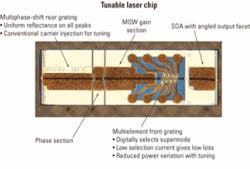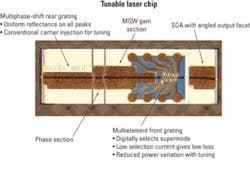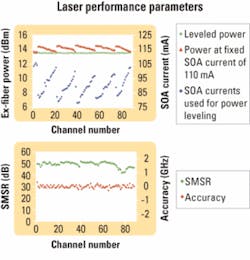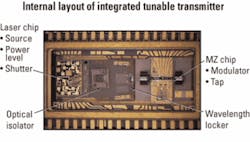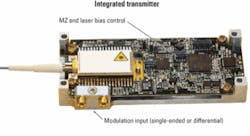Colorless optics drives metro growth
Tunable lasers have long been seen as a highly desirable way to simplify network design and inventory management. However, it is only over the last year or so that developers have achieved full-band tunability with performance equivalent to conventional DFB sources at near or equivalent cost points. There is now an explosion in demand for tunable transmitters that is likely to lead to tunability becoming all pervasive in DWDM networks.
The main application drivers for tunability come from the network core. With increasing IP-based traffic, the drive for reconfigurability with automated service provisioning has led to tunability becoming “table stakes” for new system deployment. There also is a drive from several directions to make systems more dispersion tolerant, which would allow 10-Gbit/sec overlay on installed 2.5-Gbit/sec routes. Together with reconfigurable optical add/drop multiplexers (ROADMs), these features enable both extreme flexibility and cost reduction in the new generation of optical systems.
From a component manufacturing viewpoint, the emergence of highly robust, manufacturable technology for tunability offers business simplification. To meet all the wavelength demands of different customers, fixed-wavelength lasers are manufactured in around 80 wavelength “bins” in both the C- and L-bands. Modulators for these products may also be manufactured in multiple bins, in both the C- and L-bands. To ensure flexible, short delivery times, inventory must be held at least at chip level, preferably at chip on carrier. Tunability offers a better alternative, especially when taken with enhancements to the modulators that enable full-band operation. Ideally, single chips now can cover the entire C- or L-band, with sufficient margin to allow for most manufacturers’ wavelength planning.
To ease the transition from fixed-wavelength sources, widely tunable lasers must be drop-in replacements for fixed-wavelength DFB devices in all aspects of performance, including output power, side-mode suppression ratio (SMSR), power consumption, and reliability. There are a wide range of different tunable laser technologies either being marketed or close to market. For a comprehensive list and detailed comparison, the reader is referred to the recent paper by Jens Buus and Ed Murphy (Journal of Lightwave Technology, Vol. 24, January 1, 2006), which is a summary of the presentations and discussions on tunable lasers from the workshop on this topic at OFC 2005. The table shows the three main categories of tunable laser, with manufacturers/developers.A key distinction between this device and some of the other widely tunable lasers is its low front tuning grating currents, which are beneficial in terms of thermal drifts seen during channel switching. The broad, coarse reflection response of the front grating also minimizes thermal crosstalk with the SOA section, giving minimal tuning change with SOA current, or during shuttering (dark tuning). The laser is packaged into a standard 26-pin butterfly module, which contains a front-facet wavelength locker, fiber coupling optics, and isolators.
The base laser is operated at relatively high power, with the SOA giving only around a 3-dB power boost. This ensures that the primary laser parameters of linewidth, SMSR, and noise are at least equivalent to those of fixed-frequency DFB devices. Figure 2 shows the basic optical parameters of the device, with power from the module leveled at +13.5 dBm by slight channel-to-channel adjustment of the SOA current. SMSR is better than 40 dBm. Overall, these parameters are equivalent to high-performance conventional DFB devices.Channel switching times in the millisecond range are achieved in the module, determined by electronic switching times.
The key MSA for tunable lasers is for the integrable tunable laser assembly (ITLA). This MSA, developed through the OIF, defines key performance parameters and interface specifications, potentially allowing system integrators greater flexibility in vendor selection to a common requirement (see Figure 3). There is still some work to be done, as the technology choices and diversity being used by manufacturers will still affect secondary parameters not specified within the MSA.The ITLA provides only the first step in tunability. The device does not allow for modulation and is typically intended for use with external modulators such as lithium niobate, sometimes in the 300-pin MSA transponder footprint. A next stage following quickly behind the ITLA MSA is the integrated transmitter. A hybrid approach could work here, copackaging the tunable laser with a full-band InP MZ modulator into a standard butterfly footprint (see Figure 4).
Such devices will lead to a range of 10-Gbit/sec full-band tunable products, meeting projected future requirements as well as currently evolving standards. In addition, the minimal footprint of the copackaged transmitter enables the next generation of small-form-factor (SFF) transponders. The next stage of evolution of the ITLA will be an integrable tunable transmitter assembly (ITTA). An integrated 10-Gbit/sec transmitter within the ITLA footprint is shown in Figure 5.
These MSA standards will remove the implementationbarriers to “all pervasive” tunability at the system level. The remaining barrier is manufacturing cost, where the choice of technology and the flexibility of the technology to meet as wide a range of applications as possible is the critical factor in determining volume and hence cost scaling. The evidence is now building that the performance and manufacturability of tunable lasers and transmitters is sufficiently stable and mature; we can look forward to the cost differentials for tunable devices becoming negligible or negative as the true costs of WDM inventory management in component manufacturing are eliminated.Andy Carter is vice president, research and development, and Jonathan White is product line manager, InP MZ and 24-pin TX portfolio, at Bookham Inc. (www.bookham.com).
